Hiking leggings are a great option when it comes to exploring the great outdoors. Unlike walking trousers, the best hiking leggings move and flex with you, and often fit better around the waist - especially when wearing a large backpack.
They're also more versatile than trousers: in addition to hiking, leggings are also fantastic for climbing, scrambling, running and fast-packing, plus other activities like yoga, and eating biscuits in a tent. Most importantly, they make your bum look great.
We're also big advocates for using them in the winter as part of a layering system, and also have our favourite pairs for the summer which happen to be cool and breathable while keeping the midge off too. Of course, there are thousands of options for hiking leggings out there, and it's difficult to know exactly what to look for in a sea of almost overwhelming choice. Thick or thin? Natural or synthetic fibre? What about pockets?

What are the best hiking leggings of 2025?
Best in test: Sherpa Kalpana Tights
Best value: Sprayway Escape Leggings
Best for comfort: Smartwool Merino Bottoms
Best for cold weather: Acai Thermal Altitude leggings
Best for durability: Fjällräven Abisko HD Trekking tights
Editor's note: This article was last updated in summer 2024, but Fliss has been out testing new leggings ever since so keep checking back for updates over the next few months.
How we tested the best hiking leggings
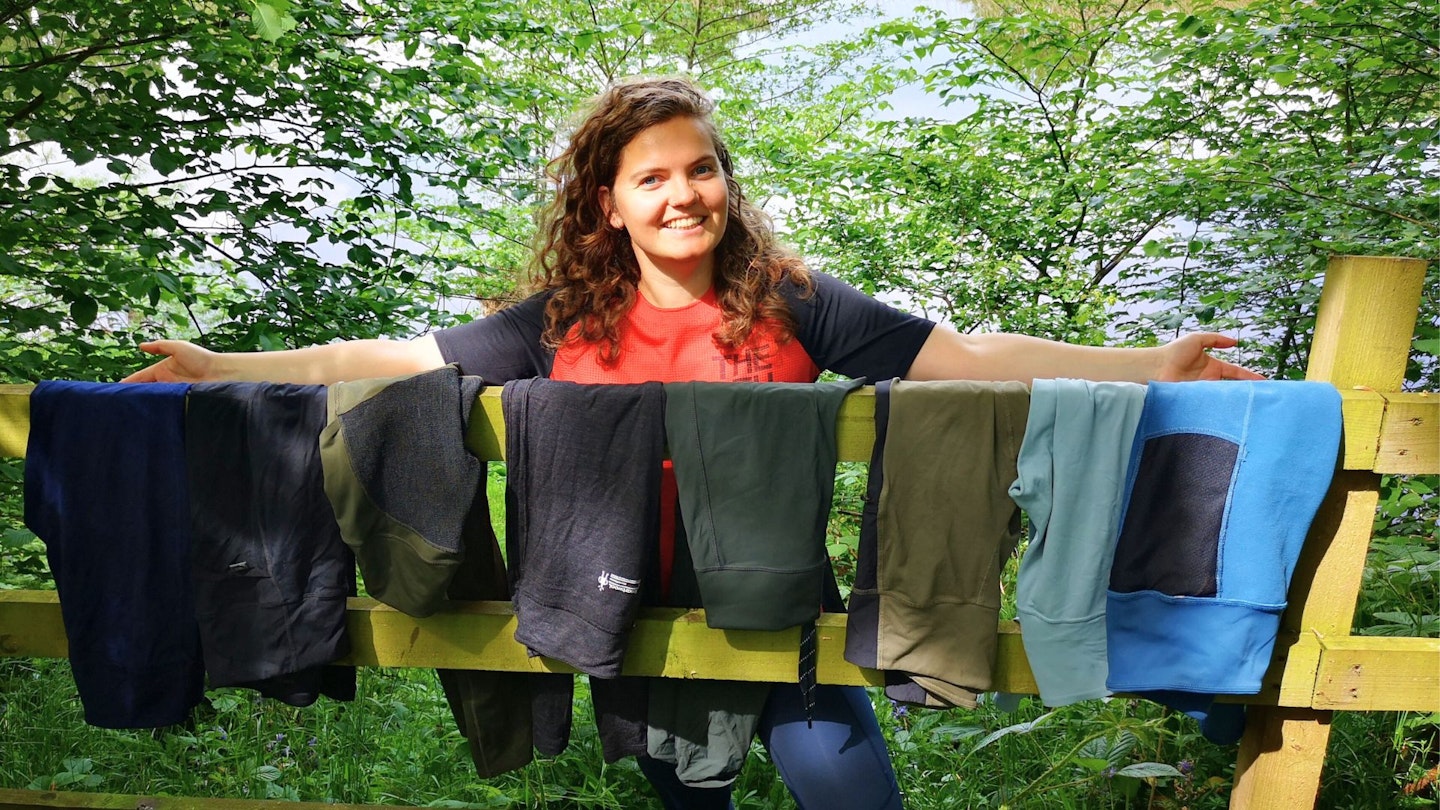
This list of leggings was tried and tested by Fliss Freeborn, a writer for LFTO and a leggings enthusiast for over a decade. She has worn many pairs of leggings in her time, ranging from £4 Primark ones to posh Nordic options that cost well over £100.
These are her pick of the bunch, all tested over winter, spring and early summer while hiking, biking and climbing in Scotland, Wales and Cornwall. You can read more about how we test here.
The best women's hiking leggings reviewed:
These really are the bee's knees of hiking leggings. We love Sherpa products for their all-round quality, and these leggings are bang on the money when it comes to balancing materials, fit, wicking properties and features. It’s an added bonus that Sherpa funds the education of children in Nepal, and is committed to using more eco-friendly fabrics too.
Made from a blend of softer SUPPLEX nylon and elastane, these high-performance leggings are perfect for hiking in the UK at most times of the year. Sure they’ll probably be a little warm in high summer, and in mid winter or torrential downpours you’ll want something to go over the top of them, but for the vast majority of the seasons, these are a fantastic bet.
They’re thick and supportive but still soft and comfortable, with great four-way stretch and a deep waistband, fitting perfectly over long periods of hiking and scrambling.
They’re also pretty durable, coping well with being scootched over tough granite, and also being one of the only pairs of leggings on test which don’t look any different after 4-5 washes. We also love the tough zipped pockets, odour control technology and the flat seams, making these leggings our best in test. And yes, £80 is a princely sum to spend on a pair of leggings, but as the old saying goes: buy nice, not twice.
Pros
- Thick, stretchy material
- Fantastic fit
- Two deep, zipped pockets
- Incredibly comfortable
Cons
- On the pricier side
| Sizes available | 2XS - 2XL |
| Materials | 76% SUPPLEX® Nylon, 24% Spandex |
| Pockets | 2 zipped Thigh Pockets |
We really liked Sprayway’s offering of the Escape leggings, especially when you realise that the RRP can be sacked off and they can be found for around £30 in many places. They’ve held up very well in testing, with no loss of elastic or burring on the seams.
They’re a great fit for the most part, and are good for moisture management on the trail, with the polyamide fabric drying quickly and keeping you cool on the uphills too.
The waistband isn’t as deep as other brands, but an adjustable drawstring helps cinch the fit in a little if needed. We also like the length of these; they go from full length to ⅞ quite easily when pulled up at the knees, also making them great for warmer days. We’ve found them to be a little saggy when sitting down on the waist area, but if anything, that makes them more comfortable, if a tad less flattering.
The open mesh pocket does leave a little to be desired in terms of security, especially when hanging upside down from a tree or climbing, but for normal-person activities like trail running and hiking, phones and keys are - happily - kept tight against the thigh. Overall these are fantastic value if you’re not wanting to splash all the cash at once.
Pros
- Adjustable drawstring fit
- Great value
- Stays pristine after many washes
Cons
- Slightly baggy for some shapes on the waist
- Mesh pocket doesn't have a secure closing system
| Sizes available | 8 - 18 |
| Materials | 4-way stretch Aqua-X fabric |
| Pockets | 1 unfastened mesh thigh pocket |
These leggings nearly won our best in test award, but were pipped by Sherpa to the top spot for a few reasons: the fabric isn’t quite as thick and durable, there’s no odour control technology, and these are also £10 more expensive.
But the Helly Hansen Blaze tights are still a brilliant bit of kit for hiking: lightweight, cut well and with reinforced knees and bum patches for durability. We love the colour choices, the stretchy polyamide-elastane mix in of the material, plus the laminated zipped pocket which stretches to fit a pretty chunky smartphone, or a well-stuffed ciabatta.
These tights are also pretty lightweight, making them a great option to carry as a spare layer, or as a backup pair of trousers should you be attempting to climb something scary. However, they’re only available in 7/8th length, which is great for ewoks like us, but does mean any tall person will suffer from cold ankles when using these leggings in the colder months.
Overall if you’re looking for something for summer walking that isn’t too thick but still is incredibly durable, then these are the choice for you.
Pros
- Great fit in the leg for petites
- Reinforced bum and knee pads
- Lightweight
- Flattering fit
Cons
- On the expensive end of things
- Zipped pocket not the most durable feeling
| Sizes available | XS - XL |
| Materials | Shell: 66% Polyamide, 34% Elastane - Shell 2: 47% Polyamide (Recycled), 41% Polyamide, 12% Elastane |
| Pockets | 1 flat zipped thigh pocket |
Acai are a brilliantly stylish brand, specialising in making women’s hiking trousers and leggings. These are their insulated, showerproof option which are designed to make winter hiking a breeze - and they absolutely do. With a tog rating of 1.1, the leggings are fleece lined, which kept us nice and toasty when the mercury dips below 5 degrees.
We’ve used them in the sleet and snow and were impressed with how warm they kept our - ahem - extremity. They’re also equipped with a DWR coating so rain beads off initially but don’t expect this to last for hours of downpour; there’s only so much the coating can do alone and the rest of the material isn’t waterproof. (This isn’t a criticism at all - having a completely waterproof legging would impede breathability and hinder movement, as well as doubling the currently reasonable RRP of £75. There is a reason waterproof overtrousers exist.)
The best thing about Acai’s thermal leggings, however, is the cut. It’s incredibly flattering, with good compression and seam placement that has evidently been thought about - we can do mad yoga moves in them as well as climb hard rock routes. We also like the unfussy thigh pocket and zipped key pocket in the waistband. If you’re looking for a winter legging that does it all, then look no further: this is the answer.
Pros
- Fleece lined for great winter warmth
- Great stretch for a flattering fit
- Well cut for scrambling and walking
Cons
- Stitching has started to burr after three months' wear
- No gusseted crotch
| Sizes available | 6 - 18 |
| Materials | 86% Polyester 14% Spandex |
| Pockets | 1 large zipped waistband pocket, one material-secured thigh pocket |
These merino tights from Smartwool are hands-down the most comfortable pair of leggings we had on test. They have a brilliant warmth-to-weight ratio and as well as wearing them under our waterproofs for very cold hikes, we’ve also been using them around our freezing Scottish tenement flat underneath our dry robe for extra warmth.
As a standalone bit of kit, they also do well. On the hill they feel so comfortable, breathable and warm that you forget you’re wearing leggings at all. They’re durable enough to stand up to the shoulder seasons in the UK by themselves, but they’re also our first choice for wearing as a winter base-layer for skiing and walking too.
As a huge plus, they’re also fantastic at not being smelly after even 3-4 days of continued wear; one advantage of being made from 100% merino. The flat locked seams feel barely there and overall, we’d recommend this as a bit of gear you’ll want to have in your wardrobe even if you’re not explicitly looking to hike in them. The price tag isn’t pretty, no, but you’re paying for high quality natural wicking materials which will last a long time.
Pros
- Supremely comfortable
- Great warmth as either a baselayer or standalone layer
- Fantastic wicking and odour control over multiday activities
Cons
- Slightly baggy after third or fourth wash
- Can get too warm for summer walking
| Sizes available | XS - L |
| Materials | 100% Merino Wool |
| Pockets | None! |
We love these supple, soft leggings from BAM for a multitude of reasons. Firstly, they’re supremely comfortable to wear just about anywhere, from the hill, to walking the dog in the park, or going to yoga - you could even dress them up a bit if you were so inclined.
We really like the deep waistband too, which gives a lovely, flattering fit to just about any figure. The material is of course, a beautifully soft bamboo fibres and elastane mix - BAM isn’t called BAM for nothing, you know.
These leggings, however, live and die by this material. On one hand, they’re incredibly lovely to wear, remaining opaque no matter what you’re doing, and fit really well, without any sign of sagging even after months of washing.
However, for serious hiking adventures, especially multi day ones that are likely to encounter wet weather or require very efficient packing, we’d recommend choosing a different pair seeing as these contain cotton so don’t dry quite as quickly as we’d like, and are heavier than many of the more technical offerings on this list.
But if you’re after something that’s multi-use, soft and comfortable for shorter, fair weather walking, then these are a great option, and at £49.99 RRP, they’re well priced for what you get in return.
Pros
- Soft and comfortable
- Great fit on the waist
- Thick material
Cons
- Heavy
- Fairly absorbent so not good for wet weather
| Sizes available | 8-18 |
| Materials | 64% Bamboo Viscose, 24% Organic Cotton, 12% Elastane |
| Pockets | 1 waistband pocket for keys |
When we first unsheathed these leggings from the packet, we couldn’t believe how buttery soft they were. They’re made of a recycled polyester and elastane mix, with a brushed, velvety feel for all-day comfort, and honestly, it feels like you’re not even wearing anything when they’re on. The waistband isn’t as defined and deep as some of the other pairs we had on test, but still manages to be flattering and comfortable, staying put on a 15km hike, and a 10km bike ride in early spring.
These leggings weigh in at just 167g, so when it comes to features, they’re understandably light. There is a key pocket in the back, but other than that, there’s little else: no side pocket for other gubbins such as a phone or a snack.
This minimalism, however, is offset by the Cross Multi 28”’s excellent quick-drying abilities - they’re the fastest drying leggings we had on test, which gives peace of mind for drizzly showers or river crossings - they dry so fast they don’t chafe or weigh you down at all. They’re also a great thing to stash in your pack as clean, dry gear for tent-lounging, or as an emergency layer seeing as they pack down so small.
The only other downsides we’d say is that these are too thin to be useful as a standalone hiking legging for the colder end of the year, and the light colour we chose does show up marks very quickly (chain-ring tats for us mostly) - but luckily these are also available in a darker green, and in black too.
Pros
- Very lightweight
- Buttery soft against the skin
- Comfortable fit
Cons
- Lighter colours show up dirt easily
- Not as durable as other branads
| Sizes available | XS - 2XL |
| Materials | 80% Polyester, 20% Elastane |
| Pockets | 1 for keys on the waistband |
Nordic brand Norrona threw their hat into the ring for this test, and we’re very glad they did. The Equaliser stretch tights are another great all-rounder for hiking and trekking, and this time come with some great eco-credentials, too. These leggings are made from over 50% recycled materials and comply with both ethics checks in the factory they’re produced in and use Oeko-Tex certified fabric, which falls above industry standards in terms of its chemical use. But does that all mean anything when it comes to performance?
Happily, yes (and at £119 RRP, we’d be fuming if it didn’t). These leggings are silky in feel, and have an athletic cut with a gusseted crotch for full flexibility. We love them for multi-activity days such as biking, climbing and walking, seeing as the lightweight material flexes and moves with you.
They’re also featured up to the nines, with two thigh pockets, zippered key pocket on the waist, a drawstring elasticated waist and use flat-locked seams to minimise chafing. If you’re also a keen long-distance trail runner and after a pair of leggings which will do both running and hiking, in all but the coldest of conditions, then these are the ones for you.
The only downside we see to these leggings is the price, which is expensive by anyone’s standards, but you are also paying for good eco credentials, and quality, lightweight gear.
Pros
- Very well made
- Fantastically athletic fit
- Lightweight
Cons
- Not great in colder weather
- No secure pocket entrance
| Sizes available | XS - L |
| Materials | 82% recycled nylon and 18% elastane 170 g/m2 blend. |
| Pockets | Two thigh pockets |
If you’re after a pair of leggings which have a supremely flattering cut, and keep you nice and dry when it’s showery out, then look no further than Acai’s showerproof softshell leggings.
If you’re into acronyms, their main USP is that they come with a DWR coating, which is great at beading up water so it runs off - keeping us completely dry during some torrential downpours in North Wales during a hike in March. (A durable water repellent coating, by the way, doesn’t guarantee full weatherproofing; these leggings are marketed as showerproof rather than fully waterproof).
These leggings also do well on the windproof side of things; unlike some of the thinner options here, these are definitely suitable for windy munro-bagging in the shoulder seasons. The nylon material, augmented with elastane for a great fit, is durable and tough too, staying completely opaque when performing acrobatic manoeuvres like doing up one’s shoelaces on the top of a cairn.
The notched V waistband is a lovely touch, making us feel great when out and about, and we love the laminated pocket too, which is just big enough for a large smartphone. The only downside we can find with these is that if you’re wearing them for long periods of time, they’re not quite as breathable as some of the other pairs on test, meaning that odours do build up and they have to be washed every couple of wears. That’s ok for 3-4 washes, and then the waterproof coating must be refreshed with a wash-in product.
Pros
- Water beads off in wet weather
- Very flattering waistline
- Comfortable fit
- Great value
Cons
- Fabric needs reproofing after 4-5 wears
- Comes up long
| Sizes available | 6 - 18 |
| Materials | 85% Nylon 15% Spandex |
| Pockets | 1 zipped thigh pocket |
Oh, Fjallraven. Only this super-duper-uber-high quality Swedish brand could get away with charging £195 for a pair of leggings. The question is, is that little leather fox embroidered on the thigh really worth that sort of cash? We think that depends on what you want to wear them for.
So, let’s start with the real positives of this pair of trekking tights, which is their superb longevity. The word “bombproof” is often overused in gear reviewing but we mean it here: the lifespan of these leggings, even with constant use, will be at least five times the next hardest wearing pair on this list (which we reckon to be the Sherpa Kalpanas, incidentally), which gives them a massive plus on sustainability grounds too.
The incredibly durable arse-and-knee reinforcements of the Abisko HDs are designed to be hoiked over rocks while climbing and mountaineering and offer a great fit for the most part. This quality alone makes them worth it if you’re out and about constantly; these leggings will soon pay for themselves if you work outdoors, perhaps in farming, labouring or as a mountain guide. In the three months we’ve been using them, they haven’t aged a day.
They’re also a great fit on the legs, knees and thighs, but where these leggings fall down (not literally - they stay up wonderfully) is in the seams, and not for the usual reason. We found the stitching to be very noticeable around the cordura patching when in motion, and when wet it can actually end up chafing slightly. However, we will caveat this by saying that we’re chunkier in the legs and thighs than most people who will end up with a size small, so perhaps this won’t be as much of an issue for other people.
If you really love high quality leggings, but can’t fathom spending nearly £200 on a pair you're only going to use every other weekend or so, then the Abisko Pros (£155) also have reinforced knees and bum patches, and they’re lighter too - but of course not quite as bombproof as the HDs.
Pros
- Extremely tough and durable, will last years
- Very well made
- Good fit with adjustable drawstring
- Reinforced knee and bum patches
Cons
- Expensive
- Seams are less than comfortable next to the skin initially
| Sizes available | 2XS - 2XL |
| Materials | Main material: 71% polyester, 29% elastane <br>Inserts: 62% polyamide, 16% aramid, 12% elastane, 10% polyester<br>DWR coating |
| Pockets | Two pockets, one on each thigh - one zipped, one flapped |
What to look for in a pair of hiking leggings
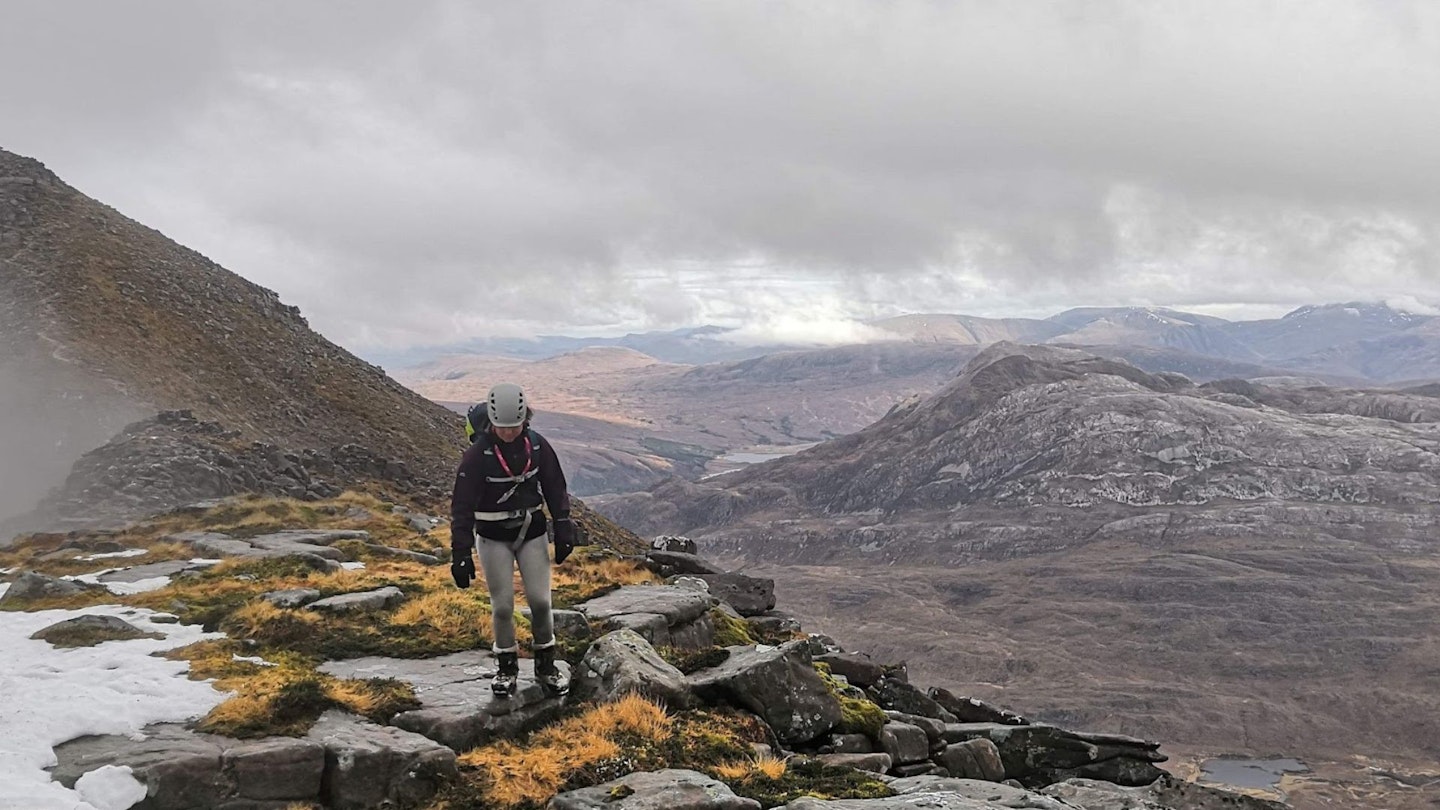
Although they all follow the same basic principle of "stick to legs and don't fall down", choosing the right pair of hiking leggings for you means considering a vast array of aspects, including materials, sizing, fit, seasonality and features. It can all get quite complicated quite quickly, so here's our breakdown of what to look for when choosing the best hiking leggings.
Fit
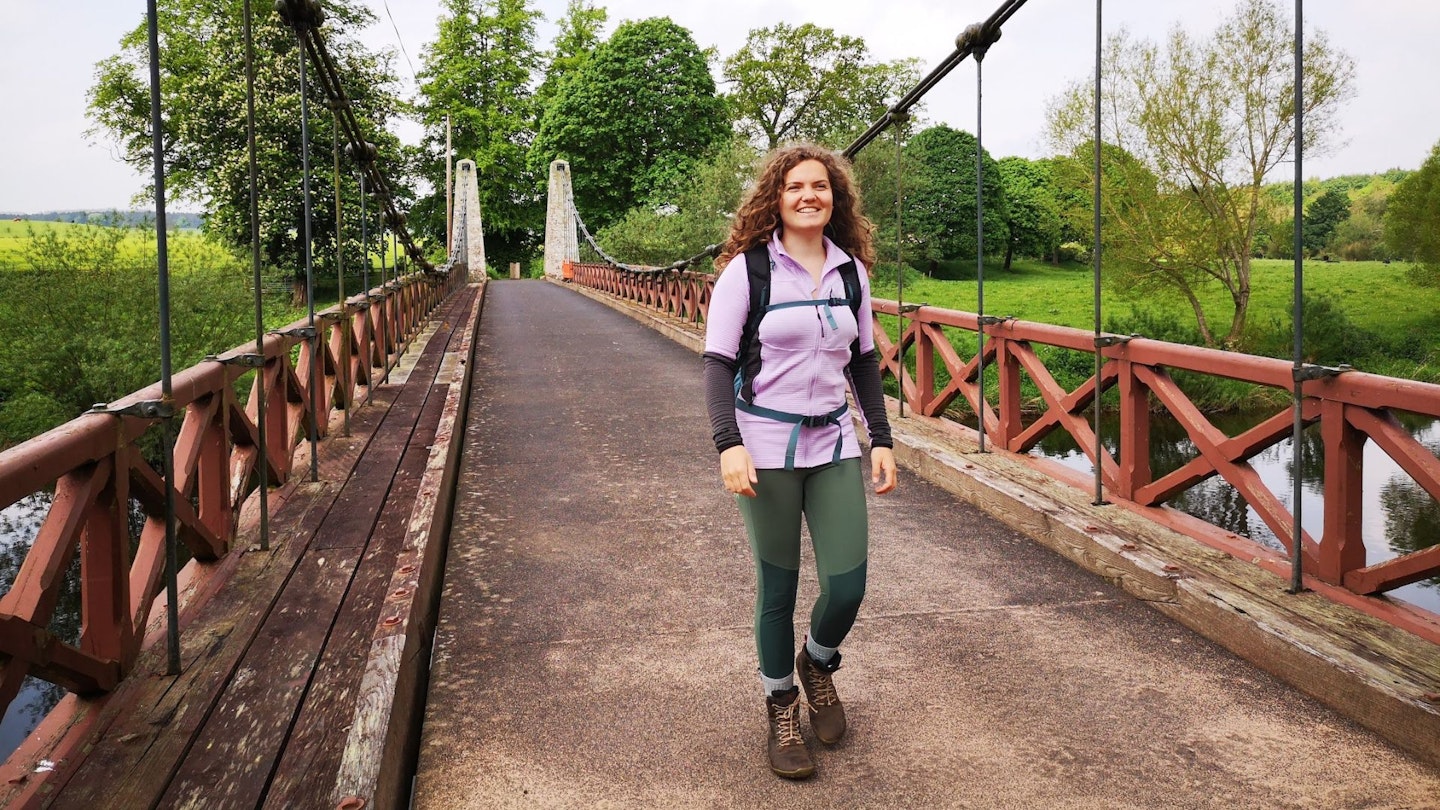
Arguably, fit is the most important thing when it comes to choosing hiking leggings. In general, leggings should fit close to your body without feeling constrictive, allowing for freedom of movement without excess fabric getting in the way.
High waisted designs are most popular, seeing as they're flattering, are less likely to fall down and offer great coverage when you're wearing a backpack - the waist-straps should sit well below the waistline of your leggings.
The truth is, you simply won't wear leggings that are uncomfortable, ride down at the waist, or need to be constantly hoiked up around the knees. To avoid this, you'll need to look closely at the size chart, determining what circumference waist or hips corresponds to the correct sizing of that particular brand, rather than just guessing or going with your usual street size.
Looking at reviews which tell you whether the sizing is accurate is a good idea too - accordingly, we opted for a mix of sizes when testing these leggings, as no one size was universal across brands.
Materials

The second most important consideration for hiking leggings is material. Whether you opt for man-made or natural materials, leggings do require some sort of stretch.
Look for 4-way stretch on the description as this will ensure no matter what activity you're up to, your leggings will remain opaque and allow you to do it with ease. In terms of the different materials on offer, here's a rundown of the most common ones on offer:
Polyester or nylon

Both polyester and nylon are durable and resistant to abrasion, making them ideal for rugged outdoor activities. When blended with spandex or elastane, they offer stretchiness and flexibility, ensuring a full range of motion during hikes.
As for breathability and wicking properties, this will vary from brand to brand, but in general, leggings made from these materials from reputable outdoor brands will have been designed with moisture management in mind.
Elastane, Lyrca, Spandex
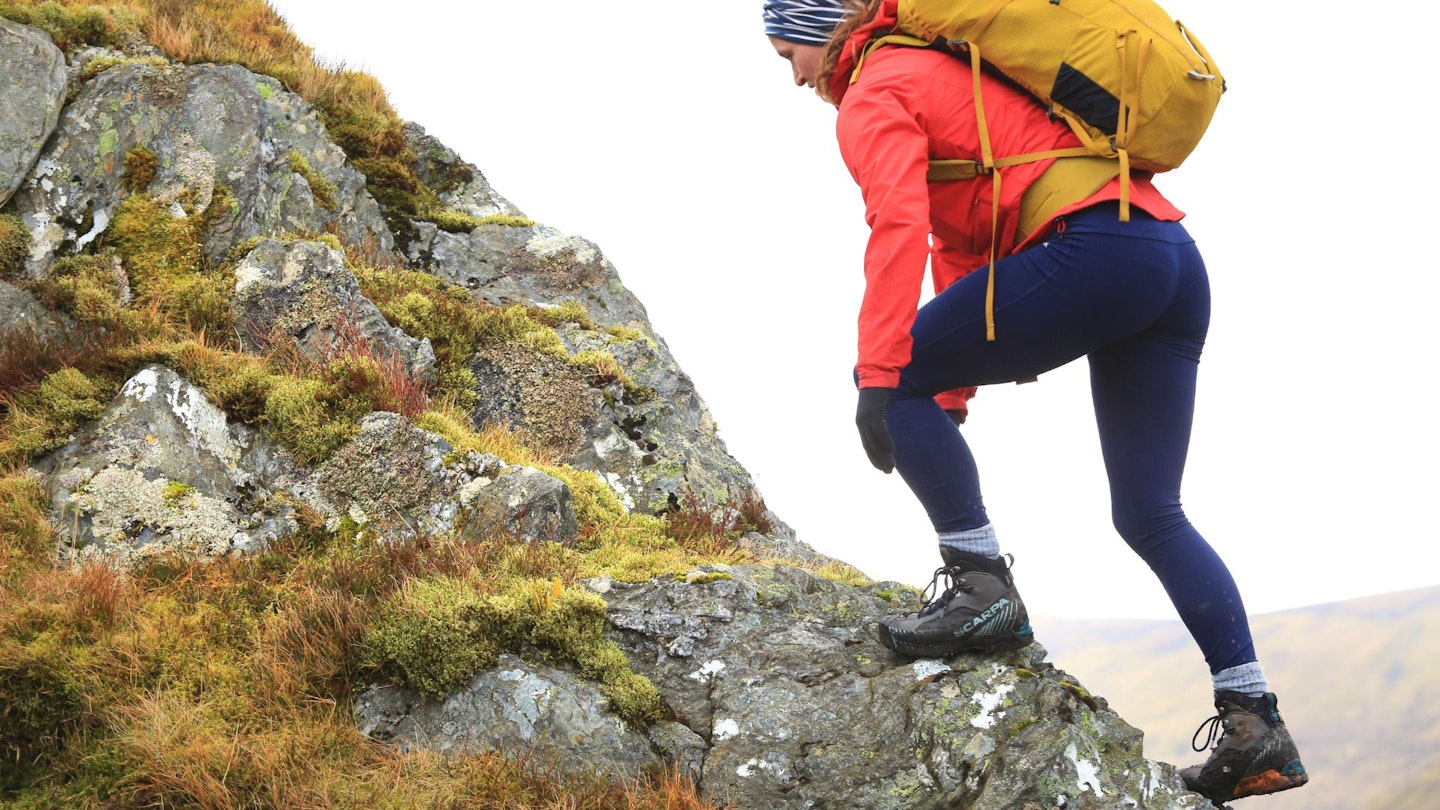
Elastane, also known as Spandex or Lycra, is a synthetic fibre renowned for its exceptional stretchiness. When combined with other materials like polyester or nylon, elastane provides elasticity and flexibility, allowing leggings to move with your body during hiking or scrambling.
It helps maintain the shape of the leggings over time, too, ensuring a snug and comfortable fit even after repeated wear and washing. Some hiking leggings incorporate compression features with elastane, which can enhance blood circulation, reduce muscle fatigue, and improve overall performance during long hikes.
Merino
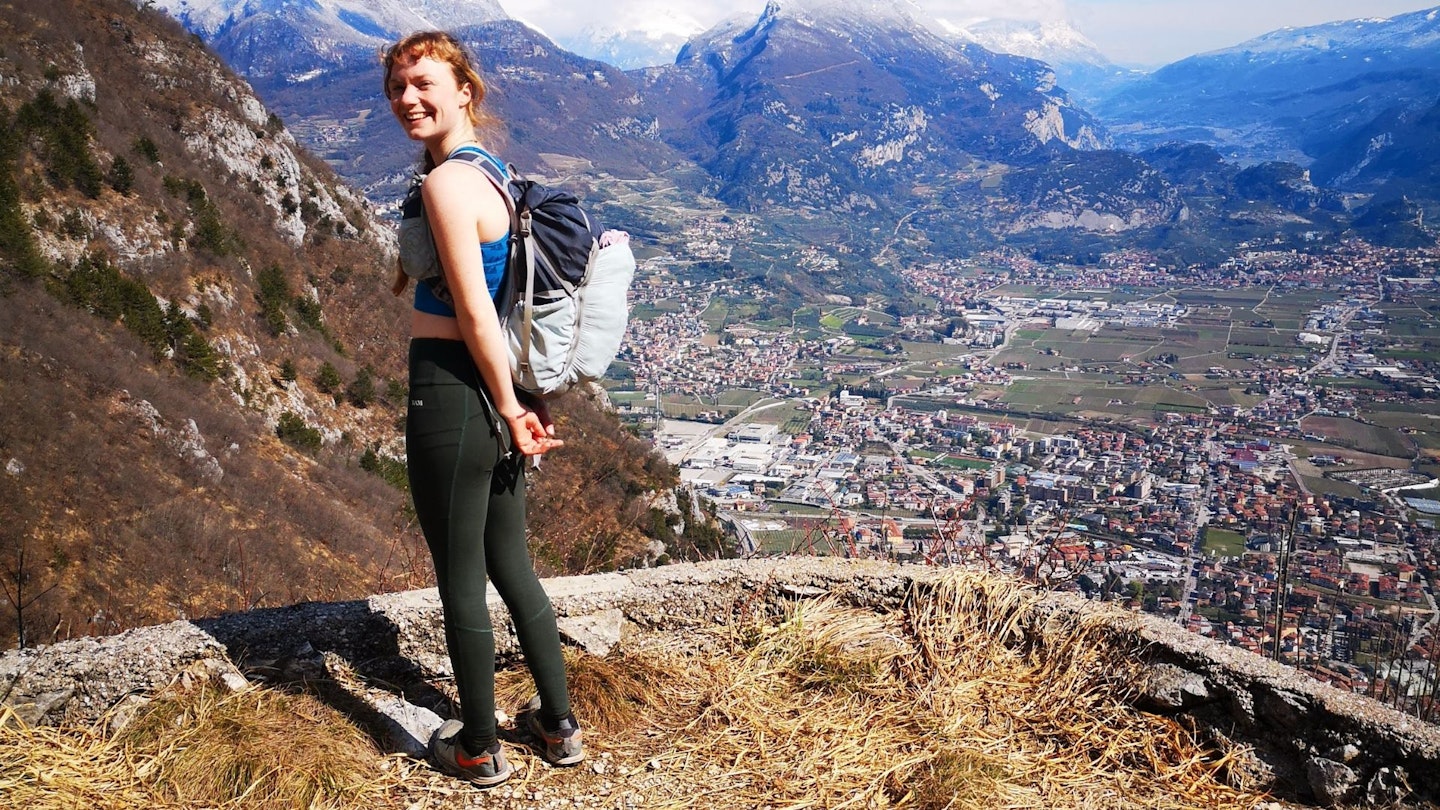
To be merino wool, it has to come from the merino region of Spain - otherwise it's just sparkling sheep fibre. Merino is special, though: whether used in pure form or blended with synthetic fibres, it offers excellent moisture management, wicking sweat away from your skin and regulating body temperature, keeping you comfortable in a variety of conditions.
Merino wool also has natural odour-resistant properties, inhibiting the growth of bacteria and keeping you feeling fresh during extended wear; especially important as a woman wearing close-fitting clothes over long periods of time. Merino is often soft and comfortable against the skin too, but commands a high price for its performance, making merino blended leggings more expensive than other synthetic materials.
Cotton or other plant fibres like hemp or linen
Cotton and other similar plant fibres are less common in hiking leggings due to their tendencies to absorb moisture and retain it, leading to chafing and the speeding up of evaporative cooling (essentially the water it retains acts like sweat), which can quickly chill you down on a cold day.
While cotton is soft and comfortable to wear, it's not ideal for walking as it dries slowly and can increase the risk of chafing or irritation, especially in humid or wet conditions.
Therefore, synthetic fibres like polyester, nylon, and spandex are preferred for hiking leggings due to their moisture-wicking, quick-drying and durable properties, ensuring a good balance of comfort and performance when out and about.
Insulation
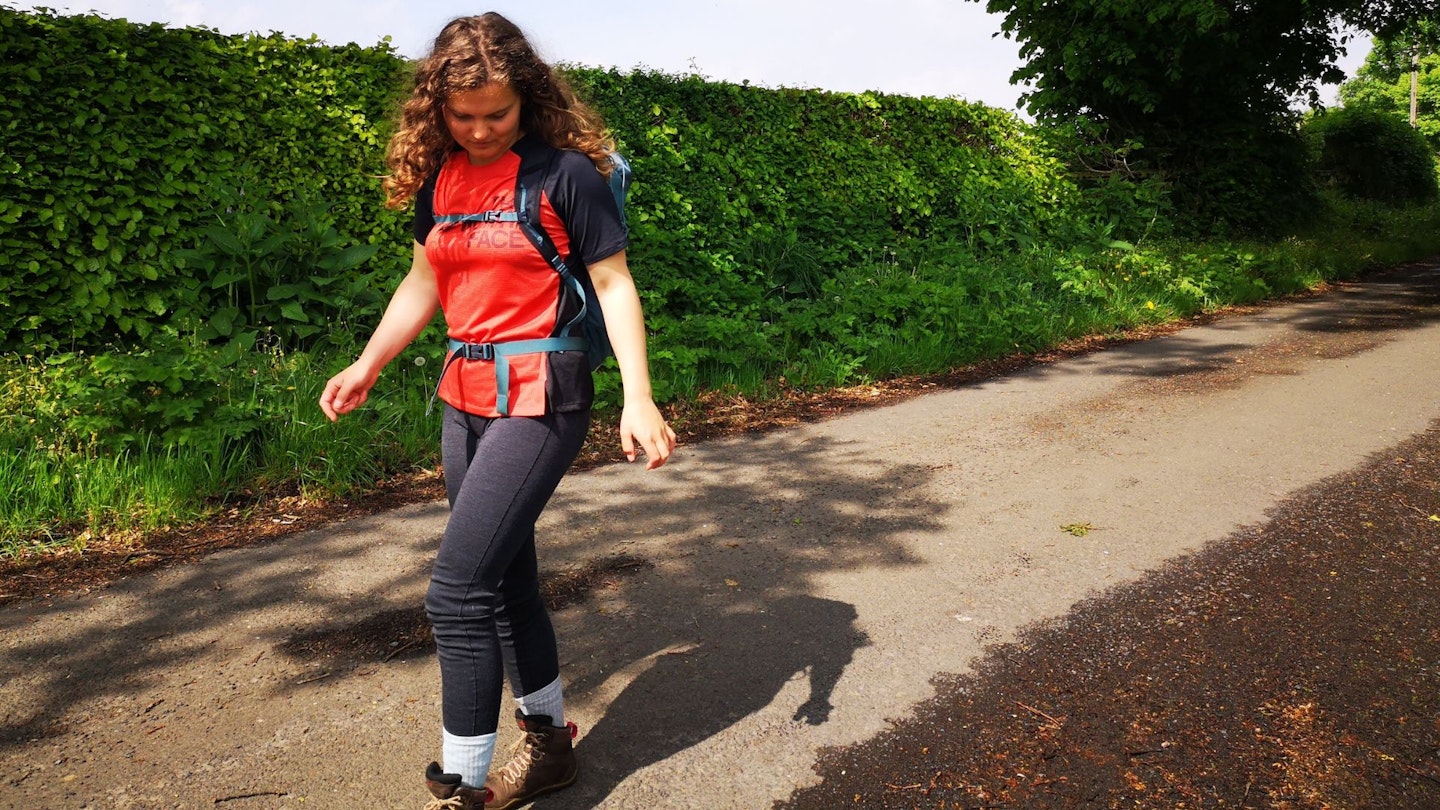
While it's tempting to opt for fleece-lined leggings for hiking, or deep pile sherpa cosy ones with claims about togs splashed all over them, be wary of over-insulating yourself.
Fully insulated leggings (and we're not talking about ones with a subtle brushed lining featured here, which are great for the colder seasons) are often false economy, as they'll make you sweaty, which will then cool you down when you stop.
You're much better off layering your leggings in the cold, starting with something made of merino and putting a lined trouser over the top, followed, in the coldest conditions, by a waterproof shell.
Length
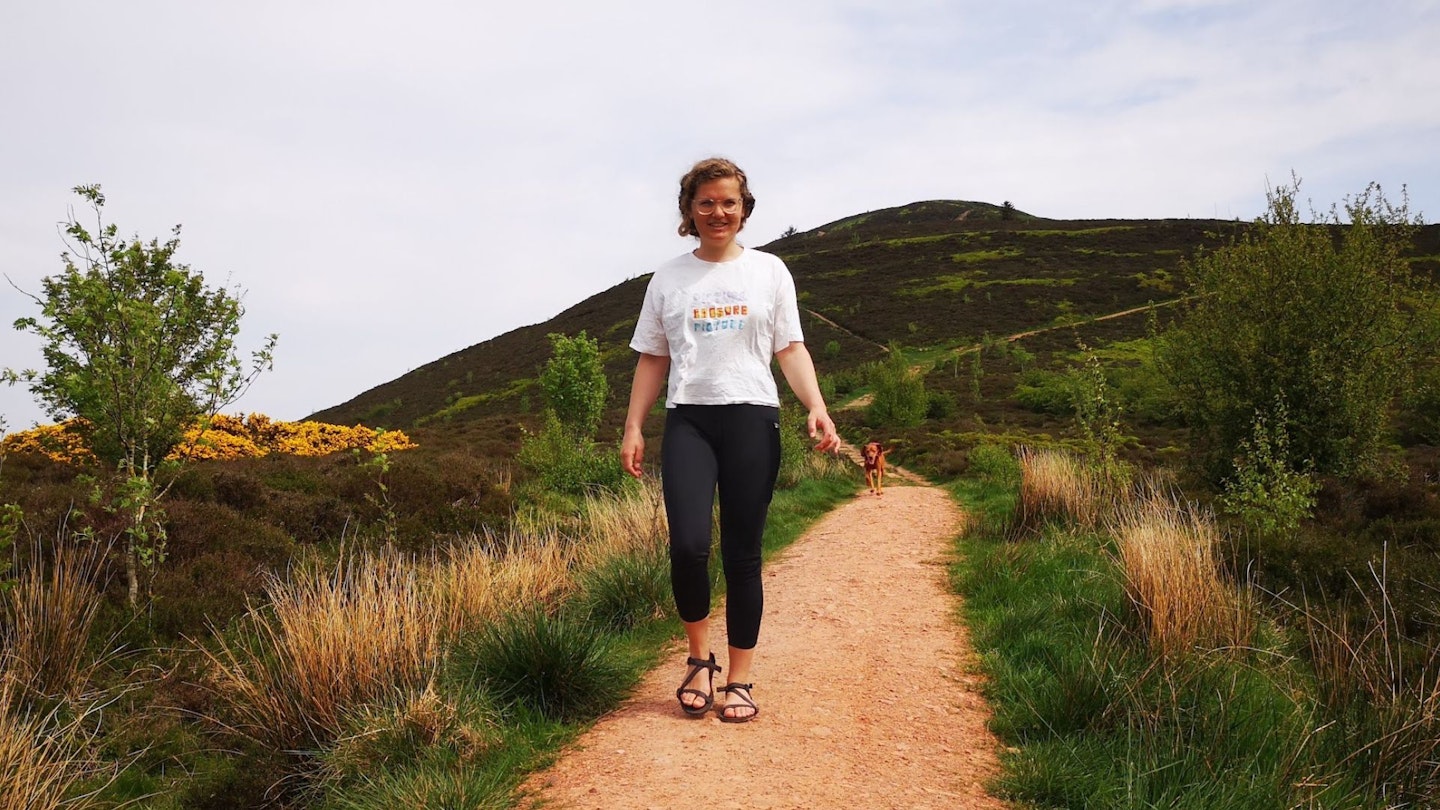
Choosing which length you want for your leggings is a bit of a conundrum, as they do tend to come in three different sizes: full length, 7/8ths and 3/4ths. Petites such as us might prefer 7/8ths, as these tend to come up as just about full size on us, but for winter or autumn hiking we'd always opt for full length.
In most cases, we've found hiking in 3/4 leggings to be verging on the side of pointless. If it's sunny enough to wear shorts, that's what we'll be doing.
Pockets
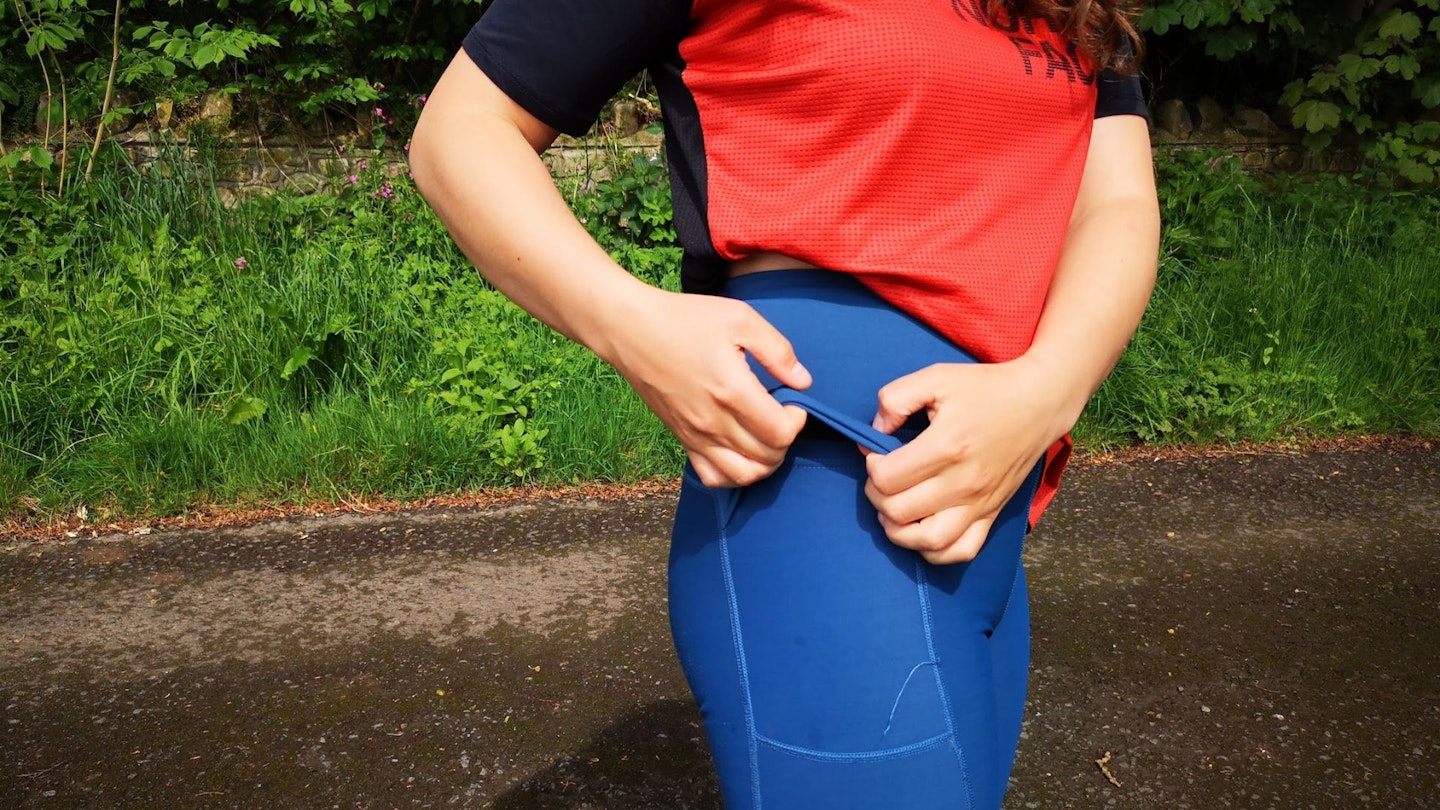
Most designated hiking leggings come with a thigh pocket for a phone, and many leggings will have storage for either keys or energy gels in the waistband too. You'll want to look for pockets with a secure entry zip or flap, to stop errant belongings escaping all over the hill if you end up going arse-over-elbow.
However, beware of zips that seem flimsy - they probably are, and won't take kindly to you overfilling your leg pocket with guff and then breaking, never to be used again. Ask us how we know.
Waistband
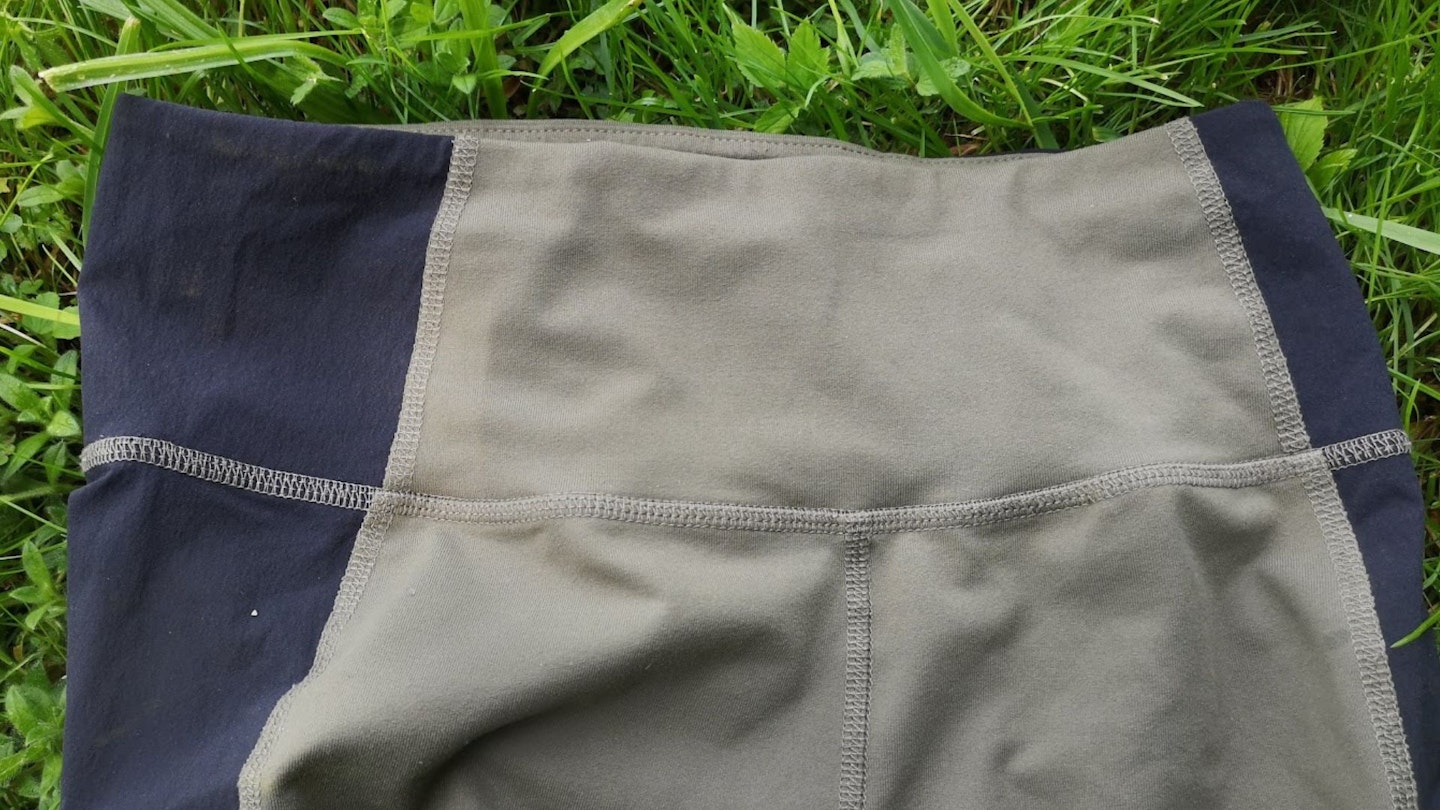
The waistband is probably the most important part of the fit of a hiking legging, as it determines the gusset height, leg length and your overall comfort when wearing a backpack or when layering tops and fleeces.
Choose leggings with a waistband which feels sturdy, deep and comfortable against the skin. It should have a good stretch but also a good spring in it; if in doubt, go slightly tighter than you usually would and it'll adjust to you as you move, coming a little bit looser after the first few washes too.
Drawstrings can help with fit but shouldn't be relied on - think of them for microadjustments only rather than as a whole belt to keep the leggings from slipping down.
Gusset and seams
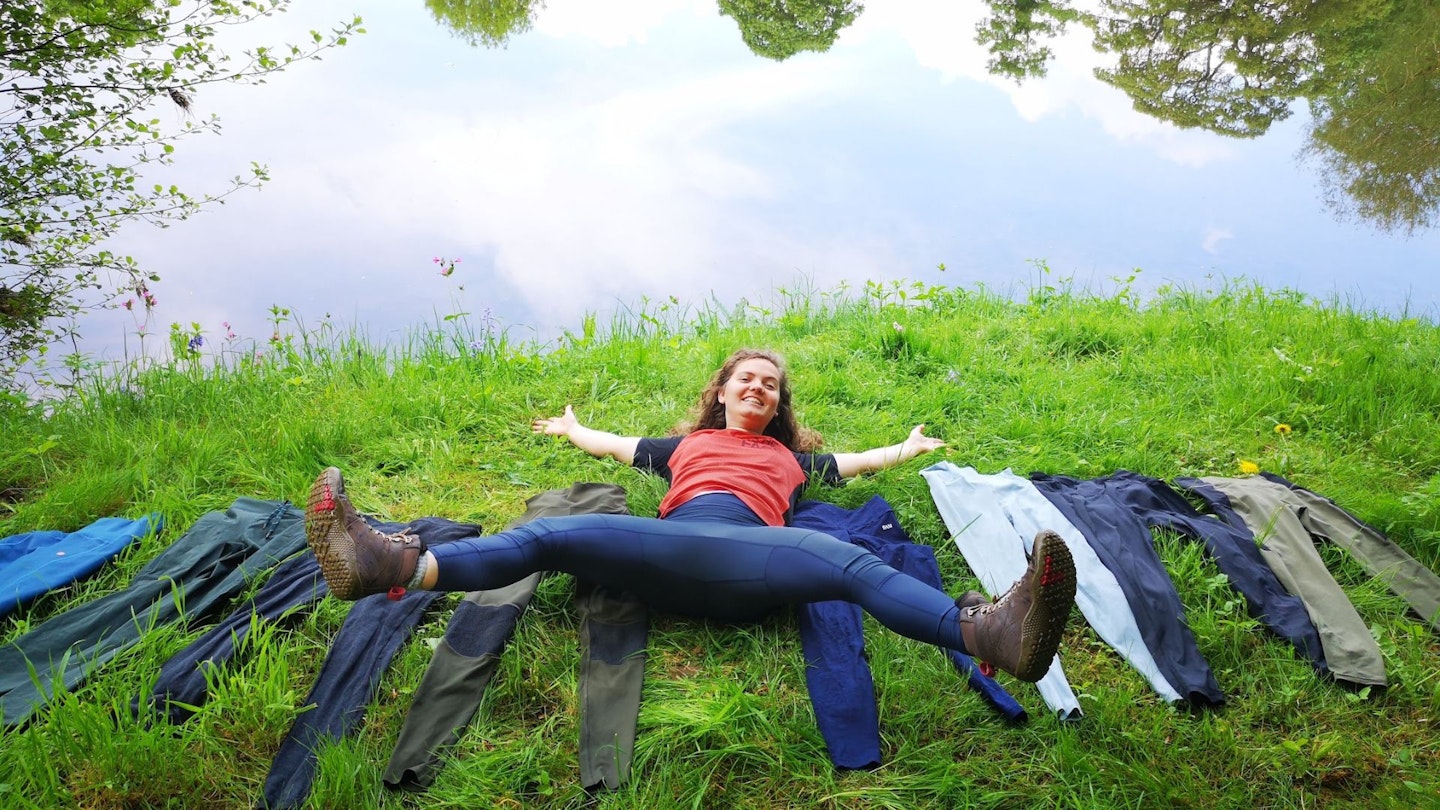
One thing we'd always look for in a pair of hiking leggings is a triangular or diamond gusset; essentially a piece of extra material on the crotch that allows for a wider range of movement.
Bonus points if it's got odour controlling technology built in, which can really help matters along when wearing the leggings for multiple days at a time.
In terms of the seams, you want to look for something that has double or even triple reinforced stitching - if you can see threads poking through from day one, then it's probably a bad investment.
Price
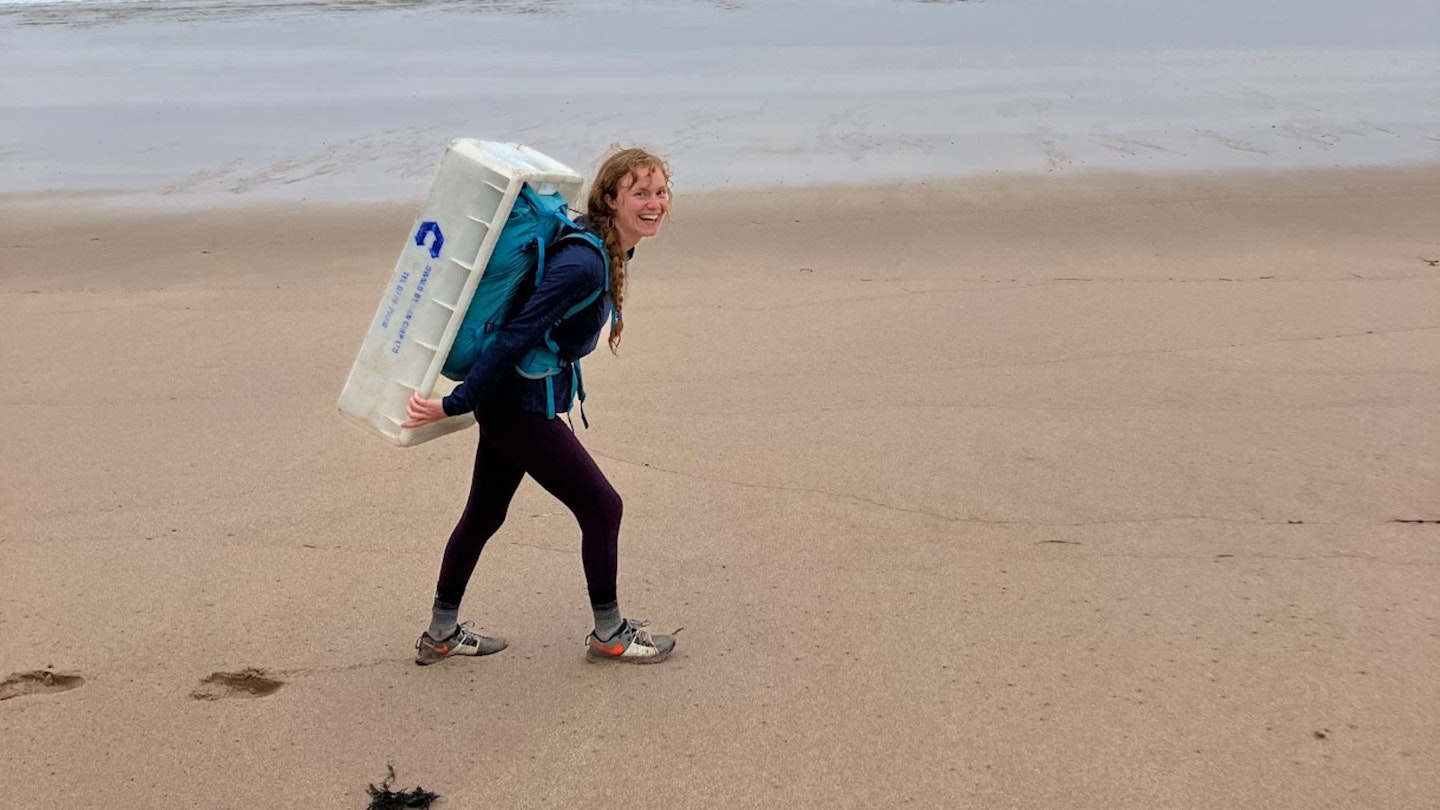
We won't lie to you, if you're spending less that £20 on a pair of leggings at RRP, then you'll end up with holes in the knees, or bum, or a saggy waistline faster than you can say "rampant unsustainable consumerism".
If you want leggings that are going to last, especially for hard-wearing activities like hiking, then spending above the £50 mark initially is advisable as you'll end up with a higher quality product, which won't fall apart on the second wash, or wear through within a couple of weeks.
We've been through many pairs of leggings in our time, ripping them on everything from chain rings, to barbed wire fences, to climbing walls and granite cliffs. We've come round to the fact that buying a higher quality pair really is worth it in the end - hence why our test doesn't include much in the way of budget options.
If you're after a bargain, then buying from a renowned brand on either a second-hand site or from a clearance retailer is a good bet.
About the author

Fliss Freebornis a writer for LFTO and really does live for the outdoors. She spent three months testing these particular leggings, in addition to the ten years prior experience she's had of putting holes in really cheap ones.
Fliss lives in Glasgow but spends little to no time there, preferring to waste her rent money by gallivanting off all over the highlands and islands instead.













































